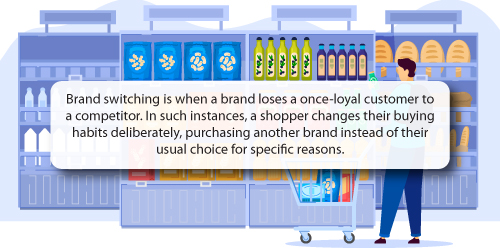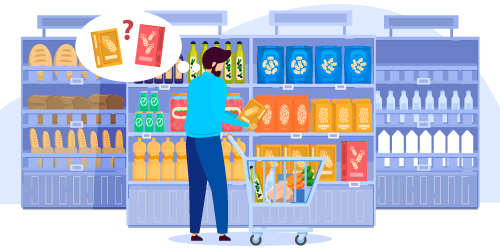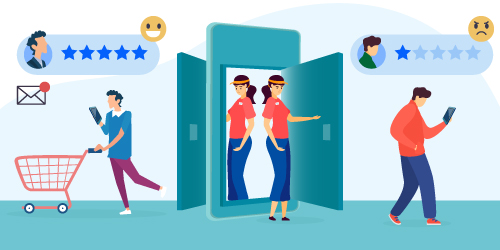It’s a widely-held belief that winning new customers costs you more than it does to keep existing ones. You’d only need to turn to Forrester Research to confirm this fact. According to the market research company, it costs you five times more. Knowing that makes it that much more vital for you to guard against the problem that is brand switching.
Of course, you also need to understand why your customers switch brands. There are plenty of reasons, many of which you can fix. That's what you'll find in this article - an explanation of why it happens. More than that, we'll provide you with ways to correct them.

What is brand switching?
Before we unpack why brand switching happens, it's critical to understand it.

As a side note, it is worth pointing out that this is not the same as brand agnostic. Brand agnostic is when a customer regularly switches between different products within a particular category. In that case, there is no threat of lost loyalty since these customers had no preference in the first place.
But we digress. To truly understand the problem of brand switching, it's worth looking at the long-term effects on a brand. The easiest way to show that is to present a practical example, like Brand 'X' that you might find at a specific FMCG retailer.
Loss in sales
Let's say Brand 'X' is in the Carbonated Soft Drinks category and it's a house brand, which means it's also a competitor to the brand leader. Within this particular category, Brand 'A' has been the best-selling item for a while. However, since introducing Brand 'X', which is 30% cheaper and tastes similar to Brand 'A', there is a noticeable drop in sales for the brand leader. Of course, since the parent company of Brand 'A' could be selling its products in multiple locations, they might not have noticed the drop-off.
However, if this trend moves to other retail stores, something would need to change, be it their price point, positioning or something else. Even if the trend doesn't move to other stores, they'd still need to monitor the situation.
Loss in market share
Besides a loss in sales, the other long-term effect is a loss in market share. A prime example here is BlackBerry smartphones. At one point, they were the darlings of the smartphone market, controlling up to 43% at its peak. However, as time passed and more smartphone brands entered the market, they suffered.
In fact, according to research and advisory firm Gartner, the company had a 0% market share for the fourth quarter of 2016. In January 2022, the company behind the phone decommissioned the use of its software, meaning BlackBerry devices running on its operating system no longer work.

Why brand switching happens (and how to fight it)
1. The price of your product doesn’t match its value
There is little doubt that your customers want value for their money. You only need to consider anyone who walks into your store to shop. Let’s say you’re a convenience store and a customer pops in on their way home from work to pick up a few items.
For the sake of this example, their shopping list includes Bread, Milk, Cereal, and a variety of other smaller items. Notice how it’s a list of products and not brands? Of course, they might know what type of Cereal brand they want to buy. However, until they reach the shelf, there is every possibility for them to change their mind.

The probability of them changing their mind increases when they get to the shelf and find a product that is priced far higher than they had expected. Or if the preferred choice is out of stock. That hesitancy is the first step toward switching to an alternative product. They're thinking about what they should buy.
The probability of them switching is further increased if there is a similar product merchandised nearby at a lower price and they view it as equal if not better. If their preferred choice is out of stock, they need to choose another item. Such an instance can also lead to brand switching.
Here’s a real example to show this.
In 2020, full-service US-based agency, Zion & Zion, conducted a survey of consumers across the USA to understand the potential long-term effects of COVID-19 on consumer behaviour.
It found that of those consumers who were forced to trial new brands during COVID-19 due to shortages, 53% to 70% expected to continue using the new brands post-COVID-19. While the probability of switching to new brands did depend on the product category, the figures are still intriguing.
For example, 65% expected to continue buying their new consumer packaged food brand.
Fortunately, you can take action to prevent this from happening. Most efforts, quite naturally, revolve around reevaluating your pricing strategy.
In this instance, the first action would be to look at your target market. And then ask these questions:
- Who is your customer?
- What are they able to spend?
- What are they willing to spend on the product?
- Are they driven by a lower price or the value of the product?
Once you’ve established that, it’s time to turn to your competitors. In doing so, ask these questions:
- What are they charging for your equivalent brand?
- What does their offering include in comparison to your product?
- Does the value they offer beat your product?
Then, of course, you must consider the economic and market conditions when calculating the most appropriate retail price.
It’s also worth reading this piece about how to find the perfect price point.
2. Your level of customer service is either poor or lacking
The level of customer service you offer goes a long way to helping you attract new shoppers and continue to satisfy your regulars. More specifically, it can mean the difference between gaining loyal customers or struggling with fair-weather ones.
In a pharmacy retailer, for example, many of your customers might not be able to collect their medicines. Thus, good customer service could include setting up a delivery service for all customers who need chronic medication. Besides pleasing your customers, you’re establishing a personal relationship with them and encouraging them to return to you for their medicinal needs.
The above example speaks more to a store’s overall retail brand. You could also look at customer service from a product-level point of view.
For example, after buying a specific item, a customer might want to return it for whatever reason. At this point, your level of service can either lead to a satisfied customer (a brand advocate who sings your praises) or an unhappy customer who will never buy from you again. You only need to visit Hellopeter or any similar website to read up on the different complaints that brands receive.

That said, it’s worth adding a caveat here. There is a big difference between poor customer service and service that is perceived as non-existent by a customer. While the first is your fault, the second has nothing to do with you.
To prevent customers from switching to a competitor's brand, it’s worth setting up a process chain with as many resources as possible. At the same time, you’d need to empower the right people to make decisions on the floor without waiting for permission.
Also, place the appropriate people in charge like people persons. After all, the last thing you want is to have an unfriendly person dealing with an angry and frustrated customer.
3. Your customers are suffering from brand fatigue
There is truth in the matter that overexposure can harm a brand or product. It’s especially pertinent to the retail industry, where there is a surplus of new products, all competing for market share. If your customer becomes tired of your brand, there is always another to replace it.
That means that you can’t rest on your laurels. While you may enjoy a significant market share today, that can change. Kodak is the perfect example here.
In 2007, Kodak was fourth in U.S. digital camera sales, with a market share of 9.6%. This, even after it was slow to anticipate the demand for digital cameras. By 2010, however, it had slipped to seventh place. In 2012, it filed for bankruptcy and announced it would stop making digital cameras.

On the other hand, there is Canon, which continually innovates and brings out different ranges and add-ons to excite customers. That said, as much as they innovate, they also ensure that they don’t stray too far away from their core range. That’s to ensure that the brand doesn’t become unrecognisable to its customers. Statista found that as of August 2021, Canon dominates the global digital camera market with 47.9%.
And that’s the key. As much as innovation is good, it can become too much. You run the risk of changing the whole purpose of your brand. An inconsistent brand image can be a product killer.
What can you do to safeguard your brand so that your customers don’t suffer from brand fatigue?
- Admit that brand fatigue can happen
This doesn't mean that it will occur, but as soon as you accept the possibility that it can happen, you'll be better prepared. More importantly, you won't take anything for granted. Don’t rest on your laurels.
- Understand why it's happening
As soon as you notice a drop-off, be that in sales or profit, understand the root cause/s. In reality, watch out for potential reasons why it could happen (if it hasn't happened already).
Why wouldn't your customer want to buy the brand? It could be that a new product has entered the market and your customers are curious enough to try it. It could be that your customers don't recognise your brand anymore. Or that you aren't listening to what they want or expect from your product.
Once you understand the cause, you can start rectifying your mistakes. If you don't think a brand can come back from the dead, here's a little inspiration.
4. You don’t understand your customers well enough
If you don’t understand why your customer is buying your product, you also won’t know why they’re switching to a different brand. After all, if you can’t satisfy their needs, they’ll buy something else, elsewhere.
Fortunately, there is a lot you can do to stop this. Better yet, there is a lot you can do to prevent it from happening. All it takes is a willingness to engage with your customer directly.
A few good barometers of customer sentiment include:
- Conducting online and in-store surveys;
- Listening and interacting on social media; and
- Engaging with customers through your loyalty programmes.
Let’s take the example of Brand ‘B’, which happens to be a unisex deodorant but isn’t selling as well as your initial market research had indicated. Why is that? Through a survey, you might find comments about the fact that women aren’t buying it because it’s usually merchandised in the men’s section and they feel uneasy going there.
On the other hand, you might find on social media that the most common criticism revolves around the main ingredient, which many customers perceive to be dangerous to their health. There might even be conversations suggesting you’re testing the product on animals.
With this information, your company can look at creating a better image of the product by substituting that specific ingredient for another, demonstrating that you’re listening. More importantly, you can show that your customers are more than just opportunities for you to make money.

Conclusion
Brand switching is a real threat. If you can accept that it can happen to you, you’ll be in a better position to prevent it. More importantly, if you can expect it, you can ensure to notice it before it's too late.
Above are a few reasons why it happens and how you can combat it. That includes:
- Offering products that a price that matches customer expectations;
- Doubling down on your customer service; and
- Listening to and understanding what your customers expect or want.
If you can get this right, you’re well on your way to ensuring that the next time a shopper is looking for an item, you’ll be the first product they place in their basket because they know you’re offering something that meets all their needs and expectations.
Are you a retailer looking to bolster your brand presence, stock the right products to meet customer expectations or find out how to maximise your retail space? Why not book a custom exploratory consultation with a DotActiv expert here? We can help you, no matter what challenges you face.


